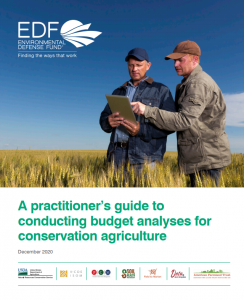Any investment, from Wall Street to a local park, requires investors to establish expectations for the costs, benefits and timing. They dedicate significant resources to researching and identifying these expectations to optimize their investment decision.
Investing in soil health should be no different.
As the U.S. Department of Agriculture, state agencies, food companies and private investors ramp up investments in sustainable agriculture, it is paramount to more widely and consistently measure and share the financial impacts that conservation practices have on the farm bottom line.
To do this, my colleagues and I developed a practitioner’s guide to help agribusinesses, universities, extensions, conservation groups and producer organizations conduct budget analyses for conservation agriculture.
The ultimate goal? Supporting farmers and their financial partners in understanding the impacts that practices like conservation tillage, cover crops and nutrient management have on farm revenue, operating costs and long-term profitability.

The guide was published in partnership with USDA’s Natural Resources Conservation Service, K·Coe Isom, Precision Conservation Management, Soil Health Partnership (an initiative of the National Corn Growers Association), American Farmland Trust, Field to Market and Datu Research.
Who is the guide for?
Many people in the agricultural sector have a stake in better understanding the financial impacts of soil health practices.
Federal and state agencies want to cost-effectively grow soil health practice adoption rates. Supply chain companies want to strategically invest in practices that will help them reach their sustainability targets. Farmers want to protect their soils while remaining profitable.
Our hope is that this user-friendly guide can help these stakeholders meet those goals.
How do I use the guide?
The guide includes basic information about what farmers need to make profitable decisions about conservation practices, based on a thorough review of 33 farm budget case studies and five multi-farm analyses that examined the impacts of conservation practices.
The guide also includes a checklist of best practices, from setting objectives and selecting a sample, to gathering the data and sharing the results in a way that can inform farmers’ and their financial partners’ decision-making. Investing in agricultural soils requires better accounting of costs and benefits on the farm bottom line. This new guide can help. Share on X
What kinds of results can I expect?
This guide was based on analyses and case studies conducted by various organizations that have shared some common general findings, including:
- Conservation tillage practices reduce fuel, labor, machinery and repair costs.
- Reducing fertilizer application to established optimal rates can reduce costs without affecting yields.
- Cover crops involve annual costs but can be profitable over time as farmers learn the best combination of seed mix, planting method and other input reductions.
By making the practice of measuring and sharing this kind of financial information more commonplace across the U.S. agricultural sector, farmers and their business partners will be able to make more well-informed decisions that support long-term profitability and resilience.









